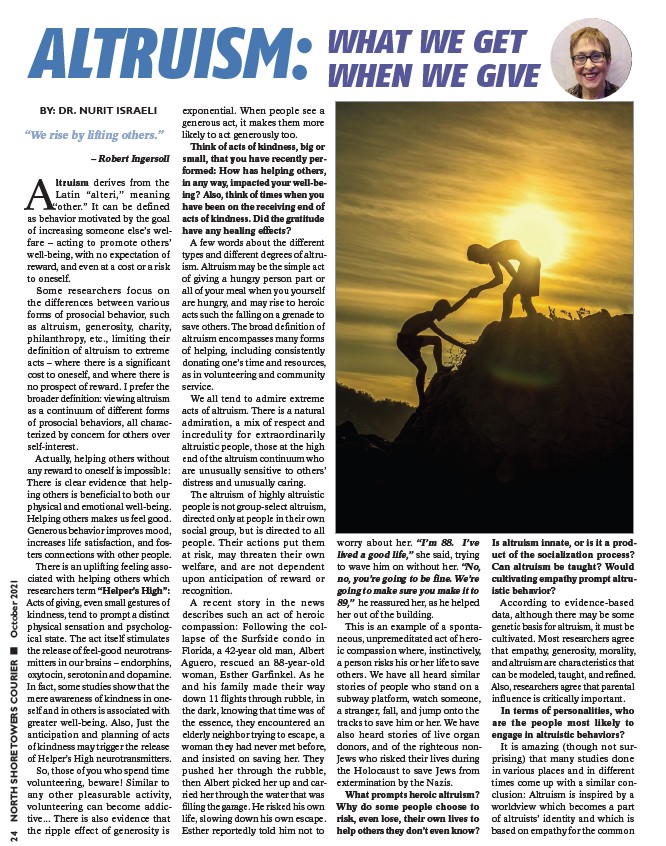
ALTRUISM: WHAT WE GET
WHEN WE GIVE
BY: DR. NURIT ISRAELI
“We rise by lifting others.”
– Robert Ingersoll
Altruism derives from the
Latin “alteri,” meaning
“other.” It can be defined
as behavior motivated by the goal
of increasing someone else’s wel-fare
– acting to promote others’
well-being, with no expectation of
reward, and even at a cost or a risk
to oneself.
Some researchers focus on
the differences between various
forms of prosocial behavior, such
as altruism, generosity, charity,
philanthropy, etc., limiting their
definition of altruism to extreme
acts – where there is a significant
cost to oneself, and where there is
no prospect of reward. I prefer the
broader definition: viewing altruism
as a continuum of different forms
of prosocial behaviors, all charac-terized
by concern for others over
self-interest.
Actually, helping others without
any reward to oneself is impossible:
There is clear evidence that help-ing
others is beneficial to both our
physical and emotional well-being.
Helping others makes us feel good.
Generous behavior improves mood,
increases life satisfaction, and fos-ters
connections with other people.
There is an uplifting feeling asso-ciated
with helping others which
2021
researchers term “Helper’s High”:
October Acts of giving, even small gestures of
kindness, tend to prompt a distinct
physical sensation and psycholog-ical
state. The act itself stimulates
¢the release of feel-good neurotrans-mitters
COURIER in our brains – endorphins,
oxytocin, serotonin and dopamine.
In fact, some studies show that the
mere awareness of kindness in one-self
TOWERS and in others is associated with
greater well-being. Also, Just the
anticipation and planning of acts
of kindness may trigger the release
SHORE of Helper’s High neurotransmitters.
So, those of you who spend time
volunteering, beware! Similar to
NORTH any other pleasurable activity,
volunteering can become addic-tive...
worldview which becomes a part
There is also evidence that
of altruists’ identity and which is
24 the ripple effect of generosity is
based on empathy for the common exponential. When people see a
generous act, it makes them more
likely to act generously too.
Think of acts of kindness, big or
small, that you have recently per-formed:
How has helping others,
in any way, impacted your well-be-ing?
Also, think of times when you
have been on the receiving end of
acts of kindness. Did the gratitude
have any healing effects?
A few words about the different
types and different degrees of altru-ism.
Altruism may be the simple act
of giving a hungry person part or
all of your meal when you yourself
are hungry, and may rise to heroic
acts such the falling on a grenade to
save others. The broad definition of
altruism encompasses many forms
of helping, including consistently
donating one’s time and resources,
as in volunteering and community
service.
We all tend to admire extreme
acts of altruism. There is a natural
admiration, a mix of respect and
incredulity for extraordinarily
altruistic people, those at the high
end of the altruism continuum who
are unusually sensitive to others’
distress and unusually caring.
The altruism of highly altruistic
people is not group-select altruism,
directed only at people in their own
social group, but is directed to all
people. Their actions put them
at risk, may threaten their own
welfare, and are not dependent
upon anticipation of reward or
recognition.
A recent story in the news
describes such an act of heroic
compassion: Following the col-lapse
of the Surfside condo in
Florida, a 42-year old man, Albert
Aguero, rescued an 88-year-old
woman, Esther Garfinkel. As he
and his family made their way
down 11 flights through rubble, in
the dark, knowing that time was of
the essence, they encountered an
elderly neighbor trying to escape, a
woman they had never met before,
and insisted on saving her. They
pushed her through the rubble,
then Albert picked her up and car-ried
her through the water that was
filling the garage. He risked his own
life, slowing down his own escape.
Esther reportedly told him not to
worry about her. “I’m 88. I’ve
lived a good life,” she said, trying
to wave him on without her. “No,
no, you’re going to be fine. We’re
going to make sure you make it to
89,” he reassured her, as he helped
her out of the building.
This is an example of a sponta-neous,
unpremeditated act of hero-ic
compassion where, instinctively,
a person risks his or her life to save
others. We have all heard similar
stories of people who stand on a
subway platform, watch someone,
a stranger, fall, and jump onto the
tracks to save him or her. We have
also heard stories of live organ
donors, and of the righteous non-
Jews who risked their lives during
the Holocaust to save Jews from
extermination by the Nazis.
What prompts heroic altruism?
Why do some people choose to
risk, even lose, their own lives to
help others they don’t even know?
Is altruism innate, or is it a prod-uct
of the socialization process?
Can altruism be taught? Would
cultivating empathy prompt altru-istic
behavior?
According to evidence-based
data, although there may be some
genetic basis for altruism, it must be
cultivated. Most researchers agree
that empathy, generosity, morality,
and altruism are characteristics that
can be modeled, taught, and refined.
Also, researchers agree that parental
influence is critically important.
In terms of personalities, who
are the people most likely to
engage in altruistic behaviors?
It is amazing (though not sur-prising)
that many studies done
in various places and in different
times come up with a similar con-clusion:
Altruism is inspired by a